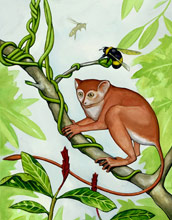Multimedia Gallery
Artist's cenception of tree-dwelling primate (Image 2)
An artist's conception of what the recently discovered tiny, tree-dwelling primate, Archicebus Achilles, might have looked like. The nearly complete articulated skeleton, discovered by an international team of paleontologists, was found in Hubei Province in central China and dates back 55 million years.
"This is the oldest primate skeleton of this quality and completeness ever discovered and one of the most primitive primate fossils ever documented," said Dan Gebo, an anthropologist on the team from Northern Illinois University (NIU). "The origin of primates sets the first milestone for all primate lineages, including that of humanity."
For scientists, one of the challenging aspects of the discovery of Archicebus has been interpreting its anatomy -- an unusual blend of features not previously viewed in combination before. The team used 3D, high-resolution reconstruction to study the fossil, aided by high-tech scanning at the European Synchrotron Radiation Facility. Analysis by the team showed the animal was very small and would have weighed less than an ounce, with slender limbs and a long tail. It would have been an excellent arboreal leaper, was active during the daytime and mainly fed on insects.
"Archicebus differs radically from any other primate, living or fossil, known to science," said team member K. Christopher Beard of the Carnegie Museum of Natural History in Pittsburgh, Pennsylvania. "It looks like an odd hybrid with the feet of a small monkey, the arms, legs and teeth of a very primitive primate, and a primitive skull bearing surprisingly small eyes. It will force us to rewrite how the anthropoid lineage evolved."
Regarding Archicebus' unusual foot anatomy, Beard says: "There's an odd combination of foot features. We see typical robust grasping big toes, long toes and nailed digits of primitive arboreal primates, but we also have rather monkey-looking heel bones and monkey-like long metatarsals, often viewed as advanced features that you would not normally find in a primitive early Eocene fossil primate. We have interpreted this new combination of features as evidence that this fossil is quite primitive and its unique anatomical combination is a link between the tarsier and monkey-ape branches of dry-nosed primates. This new view suggests that the advanced foot features of anthropoids (monkeys and apes) are in fact primitive for the entire lineage of dry-nosed primates."
Finding Archicebus is an important step toward efforts to chart the course of the earliest phases of primate and human evolution because it's the first time researchers have a reasonably complete picture of a primate close to the divergence between tarsiers and anthropoids.
Funding for the study was provided in part by the National Science Foundation (grant BCS 08-20602). To read more about this discovery, see the NIU news story Scientists discover oldest primate skeleton. (Date of Image: 2013) [See related image Here.]
Credit: Mat Severson, Northern Illinois University
Images and other media in the National Science Foundation Multimedia Gallery are available for use in print and electronic material by NSF employees, members of the media, university staff, teachers and the general public. All media in the gallery are intended for personal, educational and nonprofit/non-commercial use only.
Images credited to the National Science Foundation, a federal agency, are in the public domain. The images were created by employees of the United States Government as part of their official duties or prepared by contractors as "works for hire" for NSF. You may freely use NSF-credited images and, at your discretion, credit NSF with a "Courtesy: National Science Foundation" notation.
Additional information about general usage can be found in Conditions.
Also Available:
Download the high-resolution JPG version of the image. (2.2 MB)
Use your mouse to right-click (Mac users may need to Ctrl-click) the link above and choose the option that will save the file or target to your computer.

